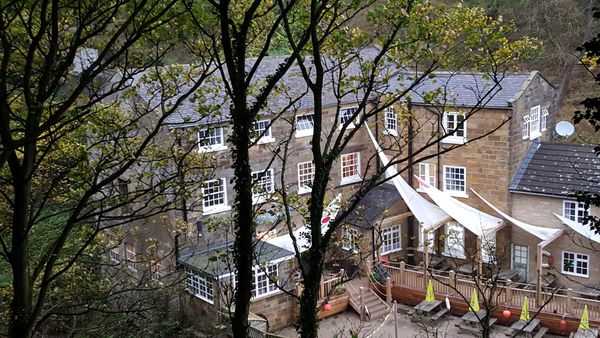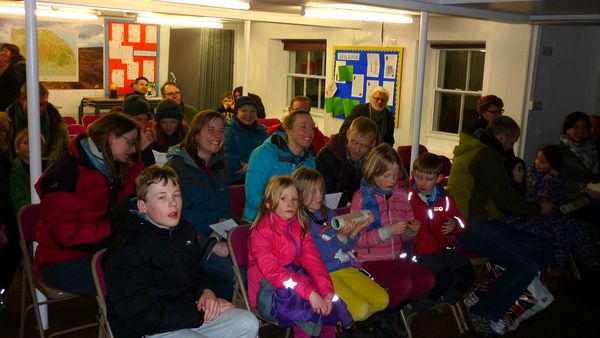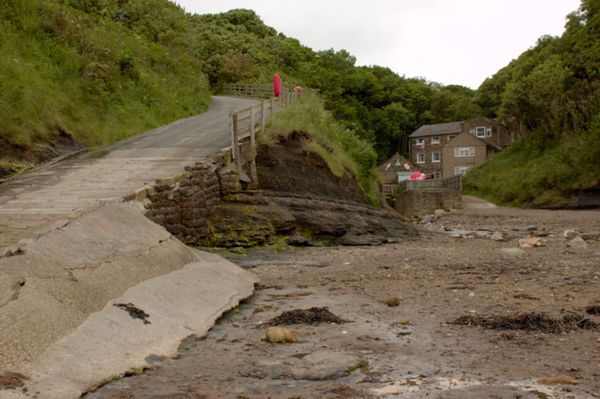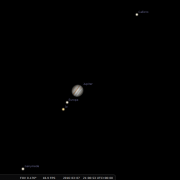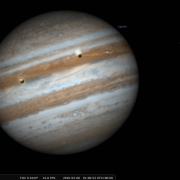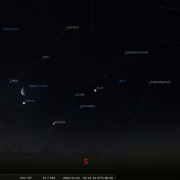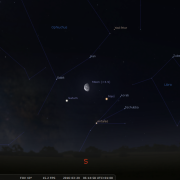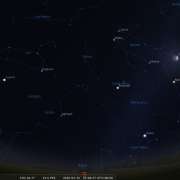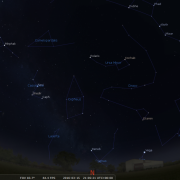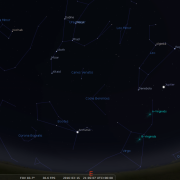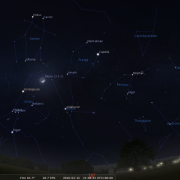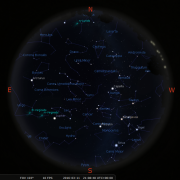Welcome to the WDAS monthly newsletter for March 2016: a digest of the month's latest contributions to our website. Below you'll find Society News, Sky Notes and In-Focus articles printed in full. There's also future events, and trailers for other articles which appear in full on the website - just a click away!
On the website you'll also be able to comment on articles, and if you'd like to play an editorial role in creating new content, just let us know!
Quick Summary for March:
- WDAS Society Meeting on Tuesday 1st March from 19:30h. There'll be an "Ask an Astronomer('s assistant)" Q&A session: some fascinating questions have been submitted!
- Star Party Events: Fylingdales Primary School on Wednesday 2nd March, and for pupils of Ayresome Primary school in Middlesbrough, slated for Tuesday 29th March at Whitby Youth Hostel. Can you help? Please let Mark know.
Society News
It has been rather a hectic mid-month, with numerous star parties and events hosted to coincide with the schools half term. Here then is an account of proceedings.
An Unexpected Journey
'Would you be able to help out?' came the plea from John T at Fylingthorpe. 'They're hosting a couple of ‘star nights’ down at Boggle Hole Youth Hostel and i think we need help'.
‘Sure we can sort something out’, said Mark, 'We’ll see you on Tuesday the 16th for the first event'.
With all the dwarfs busy, just Mark and Keith set out for the mythical ravine; the last homely house before the wilderness of Ravenscar.
Boggle Hole Youth Hostel. Click image for full-sized photo. See gallery for all photos.
Tuesday had remained cloudy all day and with little sign of change the telescopes were left behind. An indoor presentation would be in order. Having parked up at the top of the ravine the intrepid duo set off down the gorge laden with laptop, projector, screen and all the paraphernalia required for the scale solar system demo. The Boggle Hole Youth Hostel was lit wonderfully; an enchantment seemed to fill the vale, perhaps elves were watching from the trees. Alas but no, just a few bemused sheep gazed on.
On reaching the hallowed halls, we were warmly greeted by our hosts Keith and Peta and Andy, who ushered us into the already full to capacity events room. The evening went well, with a slide show and our planetarium program, bringing the night sky indoors. No time even for the scale solar system, that would wait until Thursday.
Events Room at Boggle Hole YH. Click image for full-sized photo. See gallery for all photos.
The forecast looked encouraging for Thursday night and so plans were drawn up to transport at least a couple of smaller scopes down.
A Very Expected Return
Thursday 18th dawned clear and calm and remained that way. One sensed something special lay in store as twilight deepened and the brighter stars emerged. On reaching the car park it looked as though most of the ‘Bay’ area inhabitants were determined to make the most of the fine conditions. Keith and Mark were met by Andy in the YH open back Land Rover, and whilst everyone else beat a hasty retreat down to the hostel, we paused to view the ISS low in the SW, (from the gorge this would have been invisible,- we did tell everyone)
The 'Road' to Boggle Hole YH. Click image for full-sized photo. See gallery for all photos.
With two small scopes and all the other equipment loaded into the Land Rover, we set off down, three of us squeezed in sharing the cab with a 4” tube assembly laid across our laps. (No it wasn’t a very big Land Rover) Wondering just how far we would have to carry the equipment along the narrow paths, the answer soon became apparent, we wouldn’t, as the intrepid Rover bumped across the rocky beach, forded the beck and scrambled up the slope to the hostel; - a rather unique arrival to a star party if ever there was one.
It also soon became apparent that two small scopes would not be enough; (although short of hiring a helicopter or Thunderbird 2 there was little that could be done with regard to this matter) It was heaving, 60. 70, 80, it was hard to guess how many were there. So whilst Keith manned the scopes (scope really) Mark roped in as many as possible to demonstrate the scale solar system. Fortunately there was just enough room available without sending out a search party to ‘hunt for Pluto’ on the Scar.
With a bright moon, obscuring trees and restrictive valley sides pointing out celestial objects was quite testing. Still, we coped and people seemed more than satisfied with events. Jupiter rising over the sea framed by cliff walls certainly prompted fair excitement. As regard showing the jewels of the winter sky, it is perhaps not the most ideal setting, but in every other respect it is quite remarkable ; the amenities, the ambiance at night, we shall certainly return, we just need to work out how to make it work for observing.
As we re-crossed Rio Mill Beck we could just make out John T in the moonlight striding out over the scar taking a short cut back home. I hope he made it back safely... I’m sure i saw a monstrous crab lurking in the shadows.
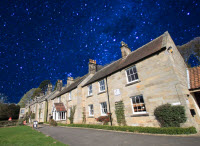 This event had been planned last year, and coincided with the centre being awarded ‘Dark sky status’ making it three sites in the North York Moors area. Richly deserved it is too, as we consider it the best ‘observer friendly’ venue of the three.
This event had been planned last year, and coincided with the centre being awarded ‘Dark sky status’ making it three sites in the North York Moors area. Richly deserved it is too, as we consider it the best ‘observer friendly’ venue of the three.
You never know what the weather will throw at you in February, so at least it was comforting that no snow lay on the ground, or that it wasn’t sub zero or blowing a gale, just cloudy, with just a hint of meatballs.
Keith, Lee and Mark made the journey over, prepared for all eventualities, packing the LX 200 as well as Lee’s scope and all the other equipment for the indoor stuff. On arrival, the hole in the clouds, visible as we drove over, started to fill in with just brief glimpses of the gibbous moon. We had already been for warned that BBC Look North were coming along, but as yet hadn’t arrived. The LX would serve as a fine (lottery funded) display scope and if required could be called into action. We set up just in front of the Centre building itself.
Tripod, levelled, scope hoisted out and placed on top we were cooking.
Keith: Where’s the spreader plate (bolts scope to stand)
Mark: it’s in the car...err..somewhere; i could have sworn I put it in, looks like it’s turned into a large misshapen car jack. ****’s!
Mark: tell you what, we’ll use the bungee cord for the dew shield and fit that round the fork base and tripod head.
Keith: Then just to make sure, lets gaffer tape round the joint. The plan worked, as long as the scope wasn’t used in GOTO mode, cue more cloud prayers.
Mark to Keith: better put an eyepiece in, there’re bound to want a picture of someone looking through it. I’ll get the eyepiece case out. Opens case to reveal a ....JIGSAW!! What! (if you’ve seen the Fawlty Towers episode in which he looks for the Duck in the large gateaux – you get the picture)
Mark: Hang about... I didn’t bring the silver case with the eyepieces in anyway, there’re in the black case with the LX controller leads. They were, crises averted.
Lee calmly set his scope up with no fuss or bother.
Whilst Keith and Lee manned the scopes in readiness, Mark legged it upstairs to prepare for his presentation. Sixty people had booked to come along to the ‘star night’ and after witnessing ‘keystone astronomers’ in action as they filed by, god only knows what carnage they were expecting upstairs. Luckily, Look North had still not arrived.
The presentations actually played out very well, the only interruption being the arrival of the Look North reporter, Phillip. After a brief tour of the night sky using the Starry Night program, and a presentation on the solar system, it was time to demonstrate the scale solar system outside. However before this, it was interview an ‘astronomer boffin’ time. Mark would have to suffice. Lights, Camera, Action... more light. ‘Geordie Mark’ squinted into the dazzling, blinding light, a metre from his face and answered the questions.
The scale solar system demonstration went down a storm with the assembled crowd. The planet ‘light spheres’ held aloft by the eager volunteers, strung out into the distance. Phillip from Look North also entered into the spirit of the occasion, apparently imitating Voyager 2, getting a gravity assist from ‘Jupiter’ and wandering off into the recesses of the outer solar system, interviewing each planet as he sped by. Somewhere en route he must have morphed into the New Horizons probe as I’m sure he paid Pluto a visit. At least that’s what it looked like from our vantage point; the planets of the inner solar system, huddled around the Sun.
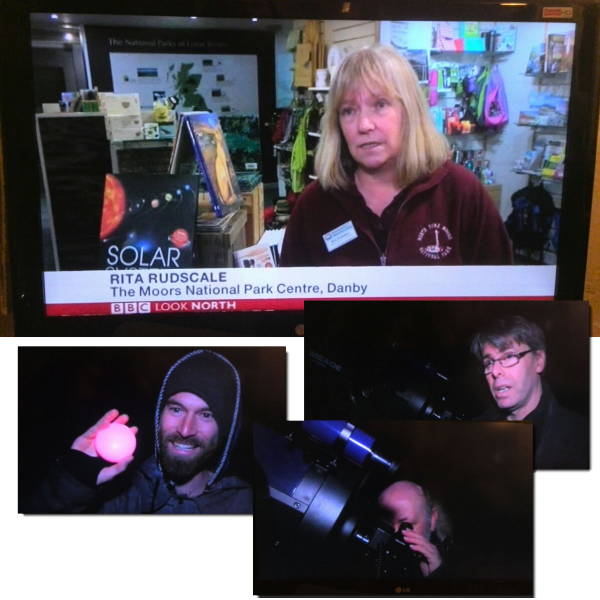
"Very pleased to have been awarded Dark Sky Status."
Rita, Jupiter, Mark and Keith on BBC Look North.
The whole charade was then played out again for all those who missed the initial launch, although Phillip must have drifted off to planet 9 as we never saw him again.
Proceedings finally drew to a close, with a short presentation in the events room. The ‘supernova element debris segment’ seemed to create quite a stir, especially when the poor woman who volunteered her gold wedding ring promptly dropped it on the floor – cue much scrabbling around. But it all added to the fun of the occasion, one which was much enjoyed by everyone. Just a shame it was too cloudy for observations. Prayers answered; maybe there is a god after all!
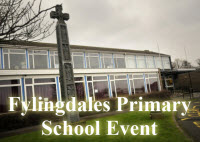 We have a couple of ‘Star nights planned in March.
We have a couple of ‘Star nights planned in March.
- The first is on the 2nd March, the night after our society meeting. This is for Fylingdales Primary School at Fylingthorpe at 18:30pm. If it is clear we shall take some scopes over (members assistance please) otherwise it will an indoor presentation with a scale solar system demo.
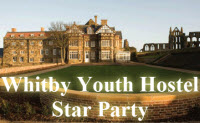 Then on the 29th (although this is yet to be confirmed) we shall be hosting an event at Whitby Youth Hostel for a visiting Schools group from Middlesbrough. Not sure on exact time, but i expect it to be around 18:30-19:00h. Again, the usual format will be adopted.
Then on the 29th (although this is yet to be confirmed) we shall be hosting an event at Whitby Youth Hostel for a visiting Schools group from Middlesbrough. Not sure on exact time, but i expect it to be around 18:30-19:00h. Again, the usual format will be adopted.
 We still not have resolved the venue issue with regard to the Paul Money lecture. The powers that be at the Museum obviously are not interested in local groups using the facility, given the price hike and other stipulations We are hoping to locate a venue in Town, but may have to look further afield depending on hire cost and capacity etc. It does though look we will have to postpone Paul until later in the year.
We still not have resolved the venue issue with regard to the Paul Money lecture. The powers that be at the Museum obviously are not interested in local groups using the facility, given the price hike and other stipulations We are hoping to locate a venue in Town, but may have to look further afield depending on hire cost and capacity etc. It does though look we will have to postpone Paul until later in the year.
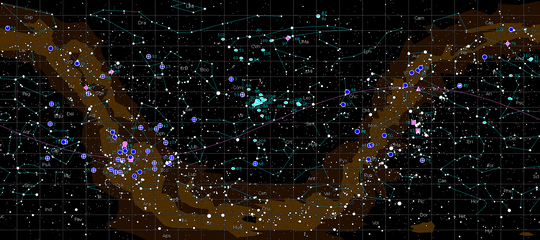
Anyone wishing to attempt a UK Messier marathon (for full details see here)
the optimum dates this year are 11 and 12th March, or April 1st & 2nd.
Sky Notes
In this month's Sky Notes:
Planetary Skylights
 Jupiter reaches opposition on the 7th when it will be visible from sunset to sunrise residing due south at local midnight. You should have no difficulty identifying Jupiter – it will be the brightest ‘star’ in the night sky. Viewed through a telescope, Jupiter is a fine spectacle, the belted disc and dance of the Galilean moons all make for fascinating observation. On opposition night itself all 4 moons will be visible; however by 01:00h on the 8th both Europa and Io will be transiting the disc, their shadows appearing as small black disks against Jupiter’s. The moon lies in the vicinity of Jupiter on the 21st.
Jupiter reaches opposition on the 7th when it will be visible from sunset to sunrise residing due south at local midnight. You should have no difficulty identifying Jupiter – it will be the brightest ‘star’ in the night sky. Viewed through a telescope, Jupiter is a fine spectacle, the belted disc and dance of the Galilean moons all make for fascinating observation. On opposition night itself all 4 moons will be visible; however by 01:00h on the 8th both Europa and Io will be transiting the disc, their shadows appearing as small black disks against Jupiter’s. The moon lies in the vicinity of Jupiter on the 21st.


 Mars and Saturn reside in the dawn sky – located to the south around 05:00h. Mars has an obvious orange hue, whereas Saturn, which resides to the left of Mars, will have a pearly white lustre. Both should be quite conspicuous. With Mars not reaching opposition until late May its disc is still rather small when viewed through a modest telescope. As the Earth draws closer matters will improve with general surface detail on Mars becoming more apparent. The Moon lies nearby on the 29th.
Mars and Saturn reside in the dawn sky – located to the south around 05:00h. Mars has an obvious orange hue, whereas Saturn, which resides to the left of Mars, will have a pearly white lustre. Both should be quite conspicuous. With Mars not reaching opposition until late May its disc is still rather small when viewed through a modest telescope. As the Earth draws closer matters will improve with general surface detail on Mars becoming more apparent. The Moon lies nearby on the 29th.
Saturn is a wonderful early morning observing tonic, as long as you have a telescope. As commented on last month, if you don’t have sufficient time to view on a morning outside;- a set up scope inside may be the solution. Whichever route you take, Saturn is a glorious sight with the open orientation of the rings. Look for its major moon Titan close by –visible as a speck of light orbiting around Saturn twice a month. Our moon lies in the vicinity of Saturn on the 30th.
Mercury and Venus have both departed from the dawn sky and will remain out of sight for the whole month.
Spring Equinox
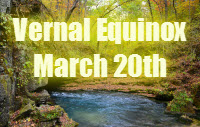 The date of the Vernal Equinox and officially the start spring in the northern hemisphere falls on March 20th this year. This is when the Sun's path - the ecliptic, first crosses the celestial equator on its apparent journey northwards into the sky.
The date of the Vernal Equinox and officially the start spring in the northern hemisphere falls on March 20th this year. This is when the Sun's path - the ecliptic, first crosses the celestial equator on its apparent journey northwards into the sky.
The orientation of the Earth at the spring or autumnal equinox is such that neither of the poles are inclined towards the Sun and all locations experience equal hours of daylight and darkness - hence the term equinox.
 The Vernal Equinox is also known as the 'First point of Aries', as the Sun used to stand before the constellation of the Ram when it first crossed the celestial equator. Although still called the 'first point of Aries', today its location now resides in Pisces, a consequence of the effect known as precession - the Earth's slow wobble over thousands of years.
The Vernal Equinox is also known as the 'First point of Aries', as the Sun used to stand before the constellation of the Ram when it first crossed the celestial equator. Although still called the 'first point of Aries', today its location now resides in Pisces, a consequence of the effect known as precession - the Earth's slow wobble over thousands of years.
Our ancestors noted that certain star patterns rose just before the Sun at specific times and were considered significant for this very reason. Subsequently they were able to build a picture of the apparent path of the Sun against these constellations.
The narrow path upon which occasionally the Sun and Moon would meet giving rise to an eclipse, became known as the Ecliptic. The broader belt along which the 'wandering stars' or planets travelled was known as the Zodiac, so called because all 12 constellations located on it were associated with living creatures.
Zodiac literally means 'Band of Animals'. Libra used to be considered being part of Scopius, the claws to be precise. Ophiuchus, the serpent bearer immediately following Scorpius was instead regarded as a zodiac group. Ever since the stars of Libra were elevated in status, Ophiuchus, being surplus to requirements, was ditched, much to the relief of astrologers. If you find it difficult to remember the order of the zodiac constellations, then the following rhyme may be of use.
The Ram, the Bull, the Heavenly twins,
and next the Crab the Lion shines,
the Virgin, and the Scales.
Scorpion, Archer and Sea goat,
The man who pours the water out
and Fish with glittering tails.
Slow Season for Meteor Showers

No major showers. However at the very end of March you may spot a few Viginids, which are very slow moving and have long paths. As usual early morning hours are more favourable
March 2016 Sky Charts
Click each image to see a full-size Sky Chart:
|
Looking South
Mid March - 21:00h |
Looking North |
|
Looking East
Mid March - 21:00h |
Looking West
Mid March - 21:00h |
|
|
|
|
Overview
Mid March - 21:00h |
|
Additional Image Credits:
- Planets and Comets where not otherwise mentioned: NASA
- Sky Charts: Stellarium Software

